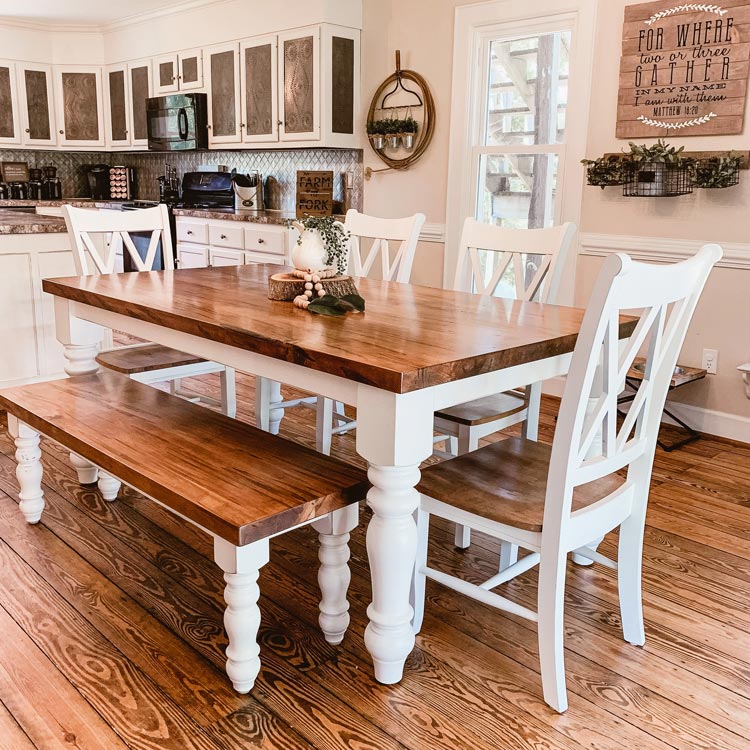The Best Materials for Durable and Elegant Dining Room Table Legs
The Best Materials for Durable and Elegant Dining Room Table Legs
Blog Article
From Typical to Modern: Discover the Ideal Eating Space Table Legs for Your Design
While classic styles such as cabriole and transformed legs stimulate a sense of ageless refinement, contemporary styles like hairpin and geometric alternatives offer an opportunity for striking visual rate of interest. As you consider these components, the concern stays: exactly how can you perfectly incorporate these diverse leg styles to create an unified eating experience?
Recognizing Table Leg Styles
The variety of dining-room table leg styles can dramatically influence both the aesthetics and functionality of the area. Each leg design adds special aesthetic aspects and useful attributes, satisfying diverse design choices and use demands. Comprehending these styles is important for choosing the appropriate eating table that straightens with your total interior decoration vision.
For example, conical legs supply a tidy, traditional look that can boost a space's beauty, while pedestal bases give security and make best use of legroom, making them excellent for smaller sized spaces. Barrette legs, a characteristic of mid-century modern layout, introduce an industrial panache, permitting a ventilated, open feeling. Trestle legs evoke rustic appeal, offering durable support and a feeling of timelessness.
Wooden legs can bring heat and appearance, whereas metal choices often communicate a streamlined, modern vibe. Eventually, recognizing table leg styles is vital for developing a cohesive dining area that mirrors individual design while guaranteeing functionality and convenience.
Traditional Table Leg Options
When selecting dining space table legs, typical options frequently symbolize classic style and craftsmanship. These designs reflect a rich heritage and a commitment to high quality, making them excellent for those who appreciate traditional looks.
Among one of the most iconic traditional leg styles is the cabriole leg, characterized by its graceful curved shape. This design typically features decorative carvings and is most generally discovered in Queen Anne and Chippendale furnishings. An additional preferred alternative is the transformed leg, which flaunts a collection of smooth, rounded forms that give a timeless appearance while preserving security.
Additionally, the straight leg, while basic, provides a unadorned and sturdy framework that can mix effortlessly with a range of tabletop styles. For those drawn to ornate describing, claw-and-ball feet legs stimulate a feeling of majesty and can function as a sensational prime focus in any type of dining space.
Lastly, pedestal bases, although not strictly legs, offer a different traditional option that permits for enough legroom and can be beautifully sculpted. Each of these standard leg designs contributes to the total atmosphere of a dining-room, marrying feature with aesthetic charm.

Modern Table Leg Designs
Modern table leg layouts use a varied array of styles that highlight tidy lines and cutting-edge products. These styles often prioritize capability while acting as striking focal points within a dining area. Minimal appearances are common, with legs crafted from materials such as steel, glass, and crafted timber, which contribute to a modern and airy feeling.
One preferred design is the hairpin leg, identified by its slim, tapered framework that supplies stability without frustrating the tabletop (dining room table legs). This style is frequently discovered in mid-century modern-day furnishings and can easily enhance different table forms. Another trend is the usage of geometric useful site shapes, where legs might tackle angular or unbalanced types, including aesthetic rate of interest and a touch of virtuosity

Mixing Styles for Unique Areas
Usually, homeowners seek to produce distinct eating spaces that reflect their individual design by blending different style aspects. This method allows for the incorporation of varied aesthetics, resulting in an unified yet unique environment. Matching a rustic wood table with smooth, modern steel legs can create a distinctive contrast that elevates the space's overall appeal.
In addition, incorporating vintage table legs with modern tabletops can evoke a feeling of history while keeping a contemporary sensibility. Such combinations not just showcase specific taste yet likewise encourage imagination, allowing house owners to curate a space that really feels both personal and inviting.
Shade plays a critical role in this mixing process; choosing table legs that complement or contrast with the existing color design can improve aesthetic interest. Whitewashed legs can soften the daring of a dark table surface, producing a well balanced aesthetic.
Tips for Picking the Right Legs
Selecting the right table legs is vital for accomplishing both performance and visual allure in your dining area. Begin by taking into consideration the overall style of your room. Standard setups gain from legs that feature elaborate makings or transformed styles, while modern spaces may require smooth, minimal designs.
Following, assess the height and stability of the legs. dining room table legs. Common table vary in between 28 to 30 inches in height, so ensure the legs complement look at more info this measurement for comfort. Furthermore, durable products, such as wood or steel, can boost security and long life
Review the leg form as well-- options include straight, tapered, or pedestal designs. Straight legs provide a traditional appearance, while conical legs can include a touch of beauty. Pedestal bases supply ample legroom and are suitable for smaller rooms.
Verdict
In recap, selecting the suitable dining room table legs calls for cautious factor to consider of both modern and standard styles. By integrating leg style, height, and product with the general décor, a natural and welcoming atmosphere can be attained.
The variety of eating space table leg designs can substantially influence both the looks and functionality of the room. Ultimately, recognizing table leg styles is important for developing a cohesive eating area that Related Site shows personal style while making certain functionality and comfort.One of the most famous conventional leg designs is the cabriole leg, characterized by its elegant bent shape. Straight legs supply a traditional appearance, while tapered legs can add a touch of elegance.In summary, choosing the excellent dining area table legs requires mindful consideration of both contemporary and typical styles.
Report this page